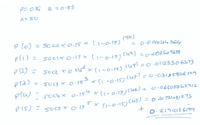Hello I am new to this website and wish to get some help on these questions regarding Binomial Distribution. See Below;

Specifically I need help with question (a&b.) I just can't seem to get my head round how these questions work and to how to even check my answer is correct.
Please see my workings out so far for question (b), I have no idea if I am on the right path, but any advice would be great.

Specifically I need help with question (a&b.) I just can't seem to get my head round how these questions work and to how to even check my answer is correct.
Please see my workings out so far for question (b), I have no idea if I am on the right path, but any advice would be great.

